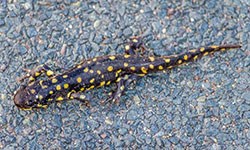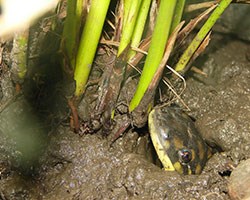|
Salamanders, while uncommonly seen in the park, may be found in the coniferous forests on the rims of the Grand Canyon. Only two species, the Utah tiger salamander (Ambystoma tigrinum utahensis) and the rarer Arizona tiger salamander (Ambystoma mavortium nebulosum), occur in the park. Both are ambystomatids (mole salamanders) meaning they spend the majority of their lives underground in burrows, usually come to the surface to only breed and occasionally after late summer monsoons. They breed in the still or sluggish water of ponds, small temporary rain pools, and cattle tanks in mid-winter to late spring. The best time to see salamanders in the park is during the breeding season when they will sometime surface at night to migrate to breeding areas. The salamander eats a wide variety of surface and subterranean invertebrates but adults can also feed on larger prey much as tadpoles, lizards, small snakes, and mice. 
Identification:

Quick Facts about Salamanders:
|
Last updated: July 22, 2015
